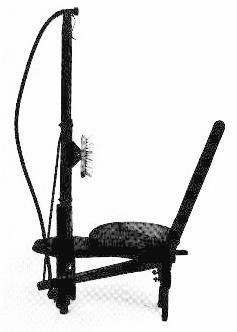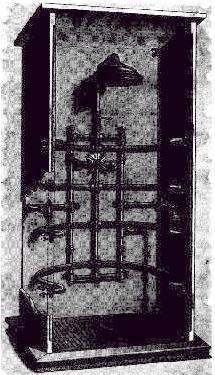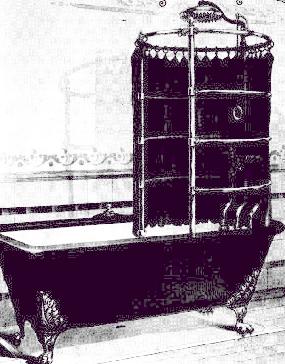The Stand – Up Bath
The need to be clean hasn’t always been as pressing as it is today. In fact, the United States is one of the few nations of the world where a daily shower is a must for most citizens. Indeed, most Americans shower rather than bath. A bath has become a way to relax – not something you do before work in the morning.
The desire to speed up the cleaning process isn’t new. Our ancestors started the showering craze with a natural showers waterfalls. This fast – falling water helped scour the bather clean. The next variation was more conducive to land – lovers, but did little to increase the user’s comfort level. After soaping up, a bucket of water, usually of the frigid variety, rinsed the residue away. The process was effective, but totally utilitarian .
That isn’t to say there weren’t some mighty fancy showers right from the start. One of the earliest and most elaborate is the English Regency Shower. Developed around 1810, the 12-foot high tote shower probably had its home in an English manor house. However, even among the English gentry, this bathing apparatus was considered most unusual and somewhat suspicious.
Made of metal painted to look like bamboo, the shower consisted of a basin with a drain on the bottom and a hidden tank at the top, joined by poles about 10 feet long. A pump arrangement on the lower basin forced water up to the top basin through one hollow pole and then down over the bather’s head. The only drawback was that the same water was reused time and time again.
Small hinges around the top held a form of a shower curtain, and the bather probably wore a tall conical hat made from an oiled materials – a forerunner of the modern shower cap. The user of this device was just as likely a man as a woman, for this was the era of the dandy, when men were as fussy as ladies about their toilettes. After showering, men would perfume themselves and choose their clothes for the day – a complicated and time consuming process.
The plumbers of the new world got into the act in the early 1800s. As plumbing moved indoors and became more prevalent, especially among the privileged homeowners in U.S. cities, alternatives to the bathtub emerged. 
Left: One of the earliest models on this side of the Atlantic was called the American Virginia Stool Shower. Developed in the 1830s, the all – wood unit was made of walnut and included a revolving seat, much like a piano stool. The machine was placed in a tub, and a hand-operated lever pumped water up to the batller’s head and shoulders. A foot pedal controlled the scrub brush that could be worked up and down the user’s back. This unit didn’t only clean away the dirt and grime, it provided an aerobic workout as well.
Craftmen’s Work: The plumbers true art – lead working – is displayed in some of the units created in the 1850s. These free standing units were crafted entirely of lead bent and wiped by hand. Hot water entered through one of the pipes at the bottom and cold water through the other. Two upright pieces of pipe with ornamental tops were blocked off where the pipe turns inward. They had no use and were include simple for decoration.
Cold water flowed directly from the intake up to the shower head. Hot water, however, was directed through a horizontal section of pipe at the center by blocking off a short curved section of pipe between one end of the horizontal pipe and the vertical pipe at the top. By adjusting a valve on the horizontal section of pipe, the amount of hot water that mixed with the cold was regulated. A faucet on the vertical pipe was included to drain the unit.

The first real heyday for the showers was the late 1800s. In the 1880s and 1890s showers were much like they are today, multiple heads, body sprays, waterfall spouts, etc.
In 1889, the J. L Mott Irons Works, manufacturers and importers of “the latest and most approved plumbing appliances for all classes of buildings,” included in its catalog its combination unit with “needle, shower, descending douche, liver spray and bidet bath.” The bather was showered with warm water from every angle.
He or she also was surrounded by pipes that moved the water to various outlets. None of the piping was concealed behind walls or in the floor. It was all exposed and formed a sort of cocoon or privacy shield around the user.
According to the catalog copy, the shower, offered in a tub or stall model, was perfect for Turkish and Russian bathing establishments, though private residences were a specialty of the firm.

The Russian and Turkish bath houses were likely the first place most early Americans saw a shower. The baths were a set – up that copied the lavish public baths of the Roman Empire. There were communal hot tubs, steam rooms and cold baths. The showers were used before and after a bather enjoyed all the other pleasures of the facility.
The grandness of these showers didn’t last. The norm for showers became the single head. Often, the set-up was crude and, once again, strictly utilitarian. At least this time the water was warm.
The possibilities for showers wasn’t tapped again until the 1980s, then it was deja vu all over again. The “vertical whirlpools” as they’re now called offer all the same creature comforts and amenities as the Mott models did more than a century before. History does indeed repeat itself.
The Stand-Up Bath © Plumbing & Mechanical 1994



Follow Us!